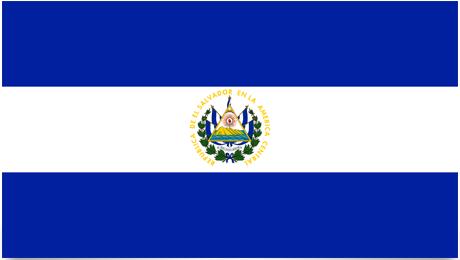El Salvador Flag and Meaning
Flag of El Salvador

El Salvador Flag Meaning
The flag of El Salvador was adopted on May 17, 1912. The two blue ribbons and the white in the middle are based on the flag of the Central American Federation from the early 19th century. In the white field is the image of the country’s coat of arms. In the coat of arms you will find the date when the country became independent (September 15, 1821) and also a picture of a rainbow and a Phrygian hat that is associated with freedom. You can also see five volcanoes between two seas that are the Pacific Ocean and the Atlantic Ocean. Below the pictures are three words: “Dios Union Libertad ?? which means something like God, unity, freedom. Between the years 1865 and 1912, the flag resembled the American one, with nine stars and blue-white stripes.
El Salvador Overview
| Population | 6.3 million |
| Currency | US $ |
| Area | 21.040 km² |
| Capital city | San Salvador |
| Population density | 299.4 residents/km² |
| HDI location | 90 |
El Salvador is the smallest and most densely populated nation in Central America, and at the same time the only one that does not have coastal stretches to the Caribbean Sea. A number of volcanoes intersect the country from east to west and the highs affect the climate. Coffee is the primary crop in the highlands, where corn, beans and rice are also grown, while sugarcane is grown on the Pacific coast, where the climate is warmer. El Salvador is one of the countries in Latin America most affected by deforestation.
The People: The Salvadorans are mainly mestizos, descendants of the Spanish conquerors mixed with the indigenous population. 89% are mestizer, 10% are Native American and 1% are of European descent.
Religion: The majority are Catholics.
Language: Spanish is the dominant and official language. Native American minority groups speak nahuatl.
Political parties: La Alianca Republicana Nacional, ARENA, the ruling party; Frente Farabundo Marti de Liberación Nacional, FMLN, founded in 1980 by the merger of 5 political-military groups: Fuerzas Populares de Liberación «Farabundo Marti», FPL; Partido Comunista de El Salvador, PCS; Fuerzas Armadas de la Resistencia Nacional, FARN; Ejército Revolucionario del Pueblo, ERP, and Partido Revolucionario de los Trabajadores Centroamericanos, PRTC. Partido Demócrata Cristiano, PDC; Union Democrática Nacional, PCN; Movimiento Auténtico Cristiano, MAC, and Unión Popular, UP.
Social Organizations: Unidad Nacional de Trabajadores Salvadoreños, UNTS; MUSYGES and Coordinadora Nacional contra el Hambre y la Represión, CNHR, founded in 1988. Consejo Coordinador Indígena Salvadoreño (CCNIS); Asociación Democrática Campesina (ADC).
Official name: República de El Salvador.
Administrative division: 14 departments
Capital: San Salvador, 1,766,000 residents (2009).
Other important cities: Santa Ana, 538,800 inb; San Miguel, 473,300 indb; Soyapango, 324,800 inb; Mexicanos, 152,900 residents (2000).
Government: Salvador Sánchez Cerén from FMLN, President since June 2014. The Parliament (Asamblea Legislativa) has 84 members.
National Day: September 15, Independence Day. (1821).
Armed forces: 30,500 men. (1995).
Paramilitary forces: The National Police Corps, Policia Nacional Civil, is composed of former guerrillas, soldiers of the national army and police.













































